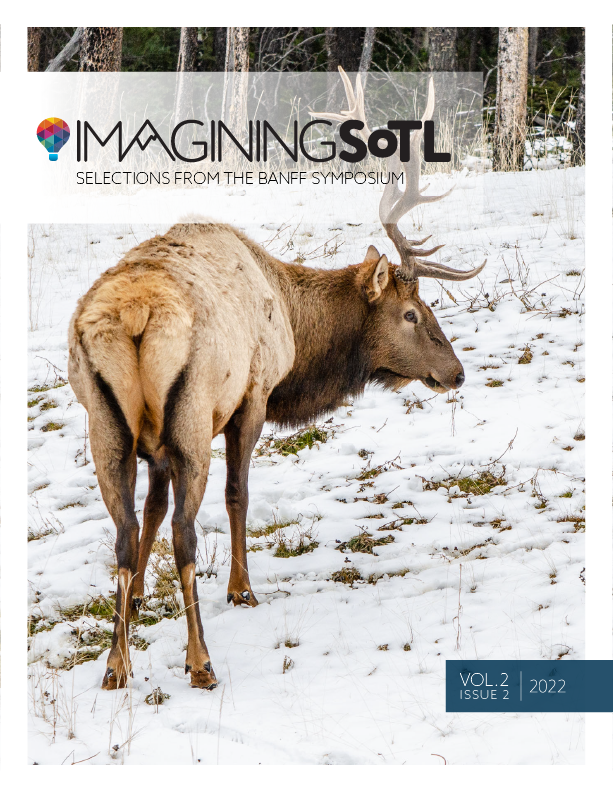Involving Students as Partners in a Course Redesign
DOI:
https://doi.org/10.29173/isotl611Keywords:
Students as Partners, SaP, course design, autoethnography, collaborative autoethnographyAbstract
As a team composed of student partners, a course instructor, and a distance learning program development specialist, we share our experiences of working together on a course development project. We used a collaborative autoethnographic approach to document and reflect on our experiences. Although our individual reflections reveal that our experiences of working together varied, we all valued working with each other and were engaged in the project. A change that we would make for future collaborations of this nature would be to invest more effort into team building and cohesion at the start of the project. We also found that individually, we all experienced our collaboration differently, which we believe is important to keep in mind when we think about inclusivity with respect to course instruction and design.
Downloads
References
Alexander, B. K. (2004). Passing, cultural performance, and individual agency: Performative reflections on Black masculine identity. Cultural Studies/Critical Methodologies, 4(3), 377–404. https://doi.org/10.1177/1532708603259680
Bovill, C. (2014). An investigation of co-created curricula within higher education in the UK, Ireland and the USA. Innovations in Education and Teaching International, 51(1), 15–25. https://doi.org/10.1080/14703297.2013.770264
Bovill, C., Cook-Sather, A., & Felten, P. (2011). Students as co-creators of teaching approaches, course design, and curricula: Implications for academic developers. International Journal for Academic Development, 16(2), 133–145. https://doi.org/10.1080/1360144X.2011.568690
Chang, H. (2013). Individual and collaborative autoethnography as method: A social scientist’s perspective. In S. H. Jones, T. E. Adams, & C. Ellis (Eds.), Handbook of autoethnography (pp. 107–122). Left Coast Press.
Cordner, A., Klein, P. T., & Baiocchi, G. (2012). Co-designing and co-teaching graduate qualitative methods: An innovative ethnographic workshop model. Teaching Sociology, 40(3), 215–226. https://doi.org/10.1177/0092055X12444072
Hanna-Benson, C., Kroeze, S., Gandhi, R., Haffie, T., & Wahl, L. M. (2020). Students as partners in collaborative course design and educational research. International Journal for Students as Partners, 4(2), 61–80. https://doi.org/10.15173/ijsap.v4i2.4237
Healey, M., Flint, A., & Harrington, K. (2014). Engagement through partnership: Students as partners in learning and teaching in higher education. The Higher Education Academy. https://www.heacademy.ac.uk/engagement-through-partnership-students-partners-learning-and-teaching-higher-education
Hess, G. (2008). Collaborative course design: Not my course, not their course, but our course. Washburn Law Journal, 47(2), 367–387.
Hudd, S. S. (2003). Syllabus under construction: Involving students in the creation of class assignments. Teaching Sociology, 31(2), 195–202. https://doi.org/10.2307/3211308
Hufford, T. L. (2011). The role of the undergraduate student in teaching and learning biology. Atlas Journal of Science Education, 1(2), 38–42. https://doi.org/10.5147/ajse.v1i2.73
Kaur, A., Awang-Hashim, R., & Kaur, M. (2019). Students’ experiences of co-creating classroom instruction with faculty—A case study in eastern context. Teaching in Higher Education, 24(4), 461–477. https://doi.org/10.1080/13562517.2018.1487930
Lubicz-Nawrocka, T. M. (2018). Students as partners in learning and teaching: The benefits of co-creation of the curriculum. International Journal for Students as Partners, 2(1), 47–63. https://doi.org/10.15173/ijsap.v2i1.3207
Moreno-Lopez, I. (2005). Sharing power with students: The critical language classroom. Radical Pedagogy. http://radicalpedagogy.icaap.org/content/issue7_2/moreno.html
Ngunjiri, F. W., Hernandez, K. C., & Chang, H. (2010). Living autoethnography: Connecting life and research. Journal of Research Practice, 6(1), 1–18. http://jrp.icaap.org/index.php/jrp/article/view/241/186
Popovic, C., Kim, A., Saleh, S., & Farrugia, L. (2021). Turning the tables: Involving undergrads as researchers in SoTL. Imagining SoTL, 1, 99–115. https://doi.org/10.29173/isotl531
Poulos, C. N. (2009). Accidental ethnography: An inquiry into family secrecy. Left Coast Press.
Rodriguez, D. (2009). The usual suspect: Negotiating White student resistance and teacher authority in a predominantly White classroom. Cultural Studies/Critical Methodologies, 9(4), 483–508.
Published
Issue
Section
License
Copyright (c) 2022 Alice S. N. Kim, Brad Jennings, Emily Tolomei, Christopher Schiafone, Lauren Dafoe

This work is licensed under a Creative Commons Attribution-NonCommercial-NoDerivatives 4.0 International License.




